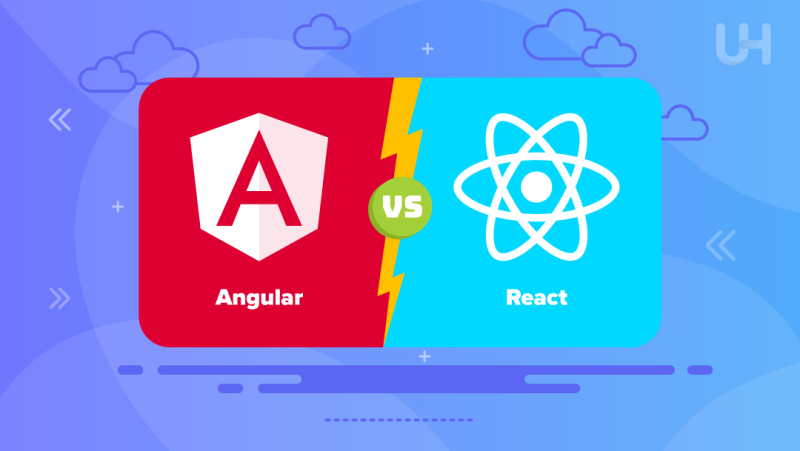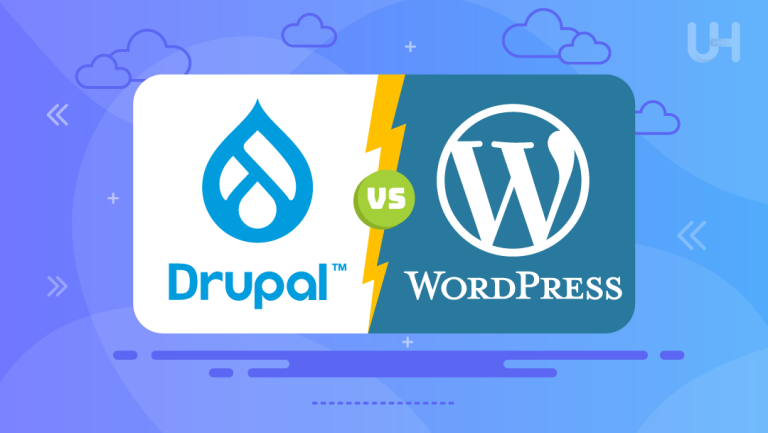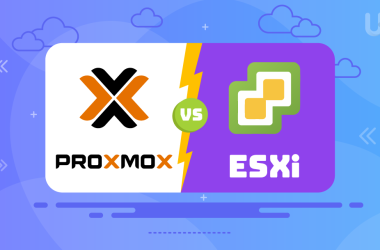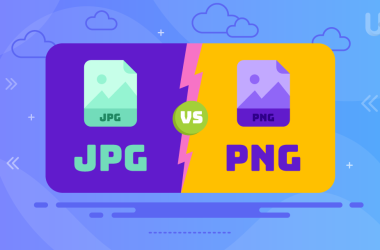If you are in the market for a capable JavaScript framework, chances are you have heard of our top two contenders: Angular vs React. They are popular JS frameworks for web and mobile development and are recommended by experts worldwide. But which is the right one for you? In this article, we compare React and Angular to help you make an informed choice.
Some say comparing Angular vs React is like comparing apples to oranges. React is a JS library built using JSX, and Angular is a JS framework built with TypeScript. While skeptics make a fair point, Angular and React share several similarities. You can even add a few libraries to React to turn it into a full-fledged framework. So, the question is, how do you choose the best JavaScript Framework? Let’s find out!
Angular vs React: An Overview
Angular is an application-design framework and front-end development platform built using TypeScript. Its component-based architecture helps create flexible and scalable web applications. The framework includes integrated libraries and useful features for routing, client-server communication, etc., to help accelerate front-end development.
On the other hand, React is an open-source JavaScript library for front-end UI development. It uses a component-based architecture with declarative views, allowing developers to easily create complex interactive user interfaces and customizable and scalable web and mobile apps. React integrates with backend JS frameworks like Node.js to serve data and handle business logic on the server side. However, Node.js is resource-intensive. So, if you plan to use it, upgrade to a Node.js hosting plan.
Angular: Key Features and Functionalities
Angular helps expert web developers build dynamic, scalable, and modular applications. Here are its key features.
- Low Learning Curve: You don’t need detailed knowledge to start building with Angular. There are tools to help support your apps as they flourish.
- Enterprise Solutions: Leverage an opinionated platform to build testable and executable UIs as your apps grow.
- Predictable Releases: Angular’s predictable release schedule helps you stay updated with the latest advancements in the framework.
- Excellent Community: Join a global community, get formal training, attend workshops, and read books before you get started.
- Powerful Interface: The Command-Line Interface (CLI) helps start a project and support it until production while maintaining consistency across teams.
- Excellent Tools: Offers a wide range of tools for development (IDE), accessibility (a11y), internationalization (i18n), and localization (i10n).
- Wide Compatibility: Angular works with any website on a secure hosting plan, such as dedicated, shared, or enterprise hosting.
React: Key Features and Functionalities
React is quickly gaining popularity for being the best JS framework. Here are its key features.
- Supports JSX: React processes JavaScript XML using JS Function Calls. It extends the ES6 to help both codes coexist.
- Powerful Components: React uses multiple components with individual logic and controls, which is crucial when working on large-scale projects.
- One-Way Data Binding: React follows unidirectional data flow, giving developers better control throughout the app.
- Virtual DOM: Any modifications to the application render the entire UI in virtual DOM, making the app faster.
- Easy to Use: React has a low learning curve since JSX is easy to code and understand.
- Performance-oriented: React uses cross-platform and programming API to write virtual components instead of using physical memory for higher performance.
- WordPress Integration: React integrates with WordPress to help build flexible, scalable websites. Web developers can leverage the WP plugin directory to boost site load speed further using WordPress performance plugins.
React vs Angular: Head-to-Head Comparison
Now that we understand the fundamentals of Angular vs React, let’s explore the differences in more detail.
Performance
Both React vs Angular are capable of building high-performing applications. Angular offers an extensive list of tools to optimize codes for better performance. Moreover, projects that don’t need two-way data binding can be served with older versions of Angular to reduce resource consumption without any noticeable impact.
In addition to breaking down the key differences in performance provided by Angular and React, developers should consider additional tools that enhance application design efficiency. Especially for those utilizing .NET Framework or Microsoft ecosystems, having access to advanced UI controls for WinForms is invaluable. With options like over 120 specialized WinForms grids, charts, and reports offered by ComponentOne, developers can build professional-grade desktop applications that connect seamlessly with existing infrastructures.
Testability
Testing code written in JavaScript is complicated. Therefore, JS programs need to be put through a stringent set of tests. Angular has multiple features that are designed with testability in mind. As a result, you can test apps built with Angular using a single tool. On the other hand, React needs a set of tools to conduct different tests. However, with the addition of the mocking function, tests are pretty predictable on React.
Elevate Your Business with VPS Hosting
Whether you’re a business seeking reliability or an individual embarking on an online venture, our VPS Hosting solutions offer the power and flexibility you need for both Windows and Linux operating systems.
Server-side Rendering
Angular renders web applications by creating a single view. It is up to the developers to increase server-side performance using client-side caching and JSON. Therefore, Angular can significantly reduce traffic between the client and server. When using React, on the other hand, developers must render the web app to the server. However, there are several ways of achieving the goal since React is pretty flexible compared to other front-end builders.
Data Binding
The biggest difference between Angular vs React is in state management. While React heavily depends on state management libraries, Angular uses built-in two-way data building to keep both layers up-to-date with the same data. Two-way data binding is extremely efficient in fetching big data from DBMS-based software, such as accounting, medical, and other software. React, however, uses one-way data binding, which renders modifications in the interface model only after the model state is updated. This means the model state remains unchanged even if the UI components are updated.
Code Quality
Angular CLI reduces the learning curve, allowing developers to predict complicated behavior easily. It reduces developers’ efforts and helps generate smooth builds, improving code quality. Angular also resolves common maintainability problems after combining HTML and JavaScript with an HTML extension. React ensures high code quality by providing Linters that help keep the codebase consistent. Instead of letting developers rewrite a code and get confused later, React influences them to develop a code that works across small modules, preventing redundancy.
Popularity
Since its launch in 2010, Angular has gained immense popularity, especially for building single-page web applications. The front-end developer received a major update in 2016, which introduced several improvements and new features to the list. Angular has continued to evolve with each new update ever since. It also integrates with WordPress, which functions as a headless CMS, unlocking advanced customization levels. However, React is a clear winner in terms of global popularity. It is easy to use and offers advanced features, such as virtual DOM, easy migration, rendering optimization, etc. It also lets developers reuse UI components, simplifying the process considerably.
Use Cases
Angular is a standalone solution for quickly building data-driven web applications. It significantly speeds up front-end development, is stable and reliable, and enjoys the support of a massive community. Here are its popular use cases:
- Develop mid-level or enterprise-scale projects where you don’t need additional plugin support or third-party integrations
- Design, scale, or maintain large or complex applications
- Build feature-packed elements or customize them
React is mostly used to handle the application’s view layer. Developers prefer it for creating reusable UI components. React is quick, flexible, scalable, and can alter data quickly without reloading the page. Here are its popular use cases.
- Building customized web applications
- Developing cross-platform mobile apps
- Creating applications with multiple events or sharable elements
Conclusion
Whether to choose Angular or React will depend on your situation. Some programmers prefer Angular over React, while others vice versa. How you utilize these frameworks decides which is the best fit for you. React is slightly more beginner-friendly, while Angular deals with HTML in a more organized manner. So, the answer to “Angular vs React: which is better” is entirely subjective. Both frameworks are equally capable, and you can use either as you prefer.
Enhance your web applications with Ultahost’s top-tier Java Hosting solutions. Enjoy unmatched flexibility, infinite scalability, and exceptional performance starting at just $5.50/month.
FAQ
React vs Angular: Which is the better framework in 2024?
Whether you should use Angular or React depends on your situation. Both frameworks are equally capable, although the use cases are slightly different.
Angular vs React: Which is easier to use?
React is easier to use than Angular. It has a lower learning curve and streamlines front-end development for beginners.
Angular or React: Which is more popular?
React is more popular globally as it is flexible, has a single view, and lets programmers handle the model and the controller. However, it is not the best framework for designing MVCs.
React vs Angular: Which is faster?
React is faster than Angular since it uses a virtual DOM instead of physical memory, saving space. Hence, React helps updates launch faster while reducing the overall app size.
Angular vs React: Which is better for front-end development?
Although React is not a JavaScript framework out of the box, its extensive library makes it more popular for front-end development.












